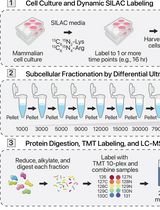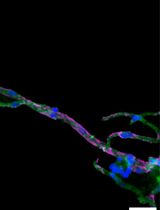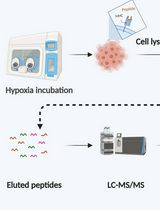- Submit a Protocol
- Receive Our Alerts
- Log in
- /
- Sign up
- My Bio Page
- Edit My Profile
- Change Password
- Log Out
- EN
- EN - English
- CN - 中文
- Protocols
- Articles and Issues
- For Authors
- About
- Become a Reviewer
- EN - English
- CN - 中文
- Home
- Protocols
- Articles and Issues
- For Authors
- About
- Become a Reviewer
Laser Capture Microdissection (LCM) of Human Skin Sample for Spatial Proteomics Research
(*contributed equally to this work) Published: Vol 13, Iss 5, Mar 5, 2023 DOI: 10.21769/BioProtoc.4623 Views: 1827
Reviewed by: Zinan ZhouDarrell CockburnAnonymous reviewer(s)

Protocol Collections
Comprehensive collections of detailed, peer-reviewed protocols focusing on specific topics
Related protocols

Protein Turnover Dynamics Analysis With Subcellular Spatial Resolution
Lorena Alamillo [...] Edward Lau
Aug 5, 2025 1686 Views

Isolation and Imaging of Microvessels From Brain Tissue
Josephine K. Buff [...] Sophia M. Shi
Aug 5, 2025 2082 Views

Immunopeptidomics Workflow for Isolation and LC-MS/MS Analysis of MHC Class I-Bound Peptides Under Hypoxic Conditions
Hala Estephan [...] Eleni Adamopoulou
Nov 20, 2025 629 Views
Abstract
In mammals, the skin comprises several distinct cell populations that are organized into the following layers: epidermis (stratum corneum, stratum granulosum, stratum spinosum, and basal layer), basement membrane, dermis, and hypodermal (subcutaneous fat) layers. It is vital to identify the exact location and function of proteins in different skin layers. Laser capture microdissection (LCM) is an effective technique for obtaining pure cell populations from complex tissue sections for disease-specific genomic and proteomic analysis. In this study, we used LCM to isolate different skin layers, constructed a stratified developmental lineage proteome map of human skin that incorporates spatial protein distribution, and obtained new insights into the role of extracellular matrix (ECM) on stem cell regulation.
Keywords: SkinBackground
Skin, the largest barrier organ in the body, has a tough and pliable structure to adapt to external conditions by quickly repairing mechanical, chemical, and biological injuries. In mammals, the skin consists of several distinct layers: the epidermal, dermal, and subcutaneous fat layers. The epidermis is the outermost layer, with stratified cell layers maintained by keratinocytes including stem cells and an abundance of mature cells (Gonzales and Fuchs, 2017). The basal layers of the epidermis, which express the keratins KRT5 and KRT14, are the location of undifferentiated proliferative epidermal stem cells (Blanpain and Fuchs, 2006). The progenitor cells replenish basal layers and differentiate into mature keratinocytes in the granulosum and spinosum layers, which express KRT1, KRT10, and involucrin. Stratum corneum, the outermost layer, consisting of terminally differentiated and dead cells, acts as a scaffold for the lipid bilayers that comprise the epidermal barrier on the skin surface (Fuchs, 2007; Koster and Roop, 2007). Keratins, which constitute the cytoskeleton of epithelial cells, are highly expressed in the epidermis, especially in the stratum corneum (Li et al., 2022). In the epidermis, the transition of keratinocytes from the proliferative basal to the supra-basal cell layer during terminal differentiation and keratinization is characterized by keratin expression transition from basal cell keratins (KRT5, KRT14, and KRT15) to supra-basal cell keratins (KRT1 and KRT10) (Moll et al., 2008).The dermis provides nourishment and support for the skin and contains an abundance of extracellular matrix (ECM) proteins including collagens, glycosaminoglycans, hyaluronic acid, fibronectin, elastin, and laminin (Nyström and Bruckner-Tuderman, 2019). Basement membrane, a specialized layer of ECM proteins connecting the dermis and epidermis, serves as an important microenvironment for basal stem cells; understanding its composition is crucial to the study of basal stem cell fate and function. However, there is a lack of detailed information about the molecular composition and regulatory function of specialized proteins localized in different skin layers that are difficult to separate, especially the basement membrane zone, during the dynamic processes of skin development, homeostasis, and regeneration for wound healing (Dengjel et al., 2020; Dyring-Andersen et al., 2020).
As described above, the skin is a complex tissue composed of heterogeneous cell types with different spatial distributions. Studying the unique physiological and pathological functions of different spatially distributed cell types is essential for understanding the molecular characteristics of human skin. Laser capture microdissection (LCM) is a powerful technique for separating target cell populations with extremely high microscopic precision, thus providing a perfect solution to the problem of skin tissue heterogeneity. Here, we describe a protocol for the isolation of different skin layers by LCM for spatial proteomics research (Li et al., 2022). Using a combination of previously developed tissue engineering decellularization methods, dedicated to the removal of epidermis and separation of basement membrane (Leng et al., 2020, Liu et al., 2020), LCM, and mass spectrometry (MS), we isolated proteins from six skin layers (stratum corneum, stratum granular-spinous, basal layer, basement membrane, superficial dermis, and deep dermis) and constructed a stratified developmental lineage proteome map of human skin. By obtaining different skin samples, the protocol enables the analysis of spatial protein expression in normal and disease-specific skin tissues, which is important for understanding the pathogenesis of different skin diseases and discovering potential therapeutic targets.
Materials and Reagents
MMI MembraneSlidesTM (MMI GmbH, catalog number: 50102)
MMI IsolationCaps transparent, 0.5 mL (MMI GmbH, catalog number: 50204)
Phospholipase A2 (Sigma-Aldrich, catalog number: P6534)
Sodium deoxycholate (Sigma-Aldrich, catalog number: V900388)
PBS (TBD Science, catalog number: PB2004Y)
EDTA (Sigma-Aldrich, catalog number: E9884)
NaCl (Sigma-Aldrich, catalog number: S9888)
DNase (Sigma-Aldrich, catalog number: 11284932001)
RNase (Sigma-Aldrich, catalog number: 10109134001)
OCT compound (SAKURA, catalog number: 4583)
4% paraformaldehyde (BOSTER Biological Technology, catalog number: AR1068)
Sucrose (Sigma-Aldrich, catalog number: V900116)
Delipidation solution (see Recipes)
DNase-RNase solution (see Recipes)
3.4 M NaCl solution (see Recipes)
30% sucrose solution (see Recipes)
Equipment
Laser microdissection system (MMI, cellcut plus)
Freezing microtome (Leica, model: CM1950)
Shaker (tcsysb, THZ-C)
Scalpel (BELEVOR MEDICAL, catalog number: 03.0030.01)
Procedure
Obtain native frozen skin tissue sections
Rinse skin tissue three times with cold PBS.
Fix tissue with 4% paraformaldehyde at room temperature for 24 h.
Perform dehydration with 10 mL of 30% sucrose solution at 4 °C until the tissue sinks to the bottom.
Freeze at -80 °C and then embed the skin tissues. Apply a layer of OCT compound in the groove of the embedding mold and place the tissue section down into the groove. Fill with embedding agent (OCT compound) and put the sample on the freezer until the embedding agent solidifies.
Cut 20-μm-thick sections of native skin tissues. Place the MembraneSlidesTM (with the MMI logo face up) close to the slice, which will stick to it. Reverse the MembraneSlidesTM, gently press them at the corresponding position below the slice with your fingers, and the sample will completely adhere to the MembraneSlidesTM.
Mount sections on MMI MembraneSlidesTM and store at -20 °C.
Obtain decellularized frozen skin tissue sections
Rinse skin tissue three times with cold PBS containing 0.1% EDTA.
Perform delipidation by treating tissue with 25 mL of delipidation solution (see Recipes) for 4 h in a shaker at 37 °C until the tissue segments become oyster white.
Gently scrap the surface of the skin with the back of the scalpel to remove the epidermis.
Rinse the decellularized dermal scaffolds with 3.4 M NaCl (see Recipes) at 37 °C for 1 h.
Wash the samples with DNase-RNase solution (see Recipes) at 37 °C for 1 h.
Rinse skin tissue three times with cold PBS.
Fix tissue with 4% paraformaldehyde at room temperature for 24 h.
Perform dehydration with 10 mL of 30% sucrose solution in a 15 mL centrifuge tube at 4 °C until the tissue sinks to the bottom.
Freeze and embed the skin tissues as in step A2.
Cut 20-μm-thick sections of decellularized skin tissues as in step A3.
Mount sections on MMI MembraneSlidesTM and store slides at -20 °C.
Laser capture microdissection (LCM) of frozen skin sections
Open LCM system. Install MembraneSlides and IsolationCaps transparent.
Switch to 4× objective and start slide scan and navigation.
Switch to 10× objective for subsequent dissection.
Set laser position indicator. Click the button to fire the laser and check whether the laser position matches the green cross. If not, click “CellCut” – “Laser” – “Set Laser Position” and click at the location where the laser is emitted.
Calibrate the parameters for the laser. Select the freehand tool, draw a long line on the empty area without tissues on the slides, and cut. Adjust “Cut velocity,” “Laser focus,” and “Laser power” to make the cutting line clear and precise.
Move to the target position, draw cut lines, and start cutting. Increase the cut velocity, cut power, and number of cuts appropriately to get the best cutting efficiency.
Pick up the sample under manual mode. Click the collecting button to attach the cutout to the EP tube cover and check if the tissue was successfully collected. If not, repeat collection or try to adjust the position of the EP tube and even recut.
Repeat steps C6 and C7 to isolate stratum corneum, granulosum-spinosum, basal layer, superficial dermis, and deep dermis on native sections and basement membrane on decellularized sections successively.
Check the entire slice to ensure that the target area is cut and collected.
Label the samples and store them at -20 °C for subsequent MS analysis.
Notes
To obtain a clearer view of tissue structure when cutting, hematoxylin-eosin staining can be performed on the sections.
The LCM systems allow simultaneous cutting of the same structure for up to 3–4 slices and collection of multiple structures with multiple tubes by using the group function.
When the sample is difficult to be dissected or collected by the EP tube cover, first check if the objective magnification is correct. Then, optimize laser parameters, such as increasing laser power or slowing down the cutting speed, and repeat the cuts. Finally, move the position of the EP tube cover to an area with less adherent samples or replace the collection tube with a new one.
The cutting circle should not be too small, or the tissue will be easily repelled away by the laser. Also, the cutting line should not be too long, or the tissue will break during collection.
For laser parameters calibration, first decrease “Cut velocity” and “Laser power” to a low value (as 5 μm/s and 5%) and cut. Then, change “Laser focus” until the cutting line becomes clear and spacious. Finally, decrease the “Laser power” to get a fine line and change the “Laser focus” again to find the finest line. After calibration, increase the “Cut velocity” to a high value (as 70 μm/s) and increase the “Laser power” accordingly to get a fast and precise cutting line. For best cutting efficiency, change “Cut velocity” and “Laser power” according to different tissue locations and thickness.
Videos 1–5 show the continuous process of cutting the stratum corneum, stratum granulosum-spinosum, basal layer, superficial dermis, and deep dermis of the native skin tissue sections from outside to inside. Video 6 shows the process of cutting the basement membrane of the decellularized skin tissue sections.
Video 1. Isolation of stratum corneumVideo 2. Isolation of stratum granulosum-spinosumVideo 3. Isolation of basal layerVideo 4. Isolation of superficial dermisVideo 5. Isolation of deep dermisVideo 6. Isolation of basement membrane
Recipes
Delipidation solution
Dissolve 10 g of sodium deoxycholate powder in 1 L of deionized water.
Add phospholipase A2 to above solution before delipidation treatment to make a final concentration of 2,000 U/L.
DNase-RNase solution
Dissolve 1 mg of DNase powder and 0.5 mg of RNase powder in 100 mL of PBS buffer before use.
3.4 M NaCl solution
Dissolve 198.9 g of NaCl powder with 800 mL of deionized water.
After dissolving, fill with deionized water to 1 L.
30% sucrose solution
Dissolve 300 g of NaCl powder with 800 mL of deionized water.
After dissolving, fill with deionized water to 1 L.
Acknowledgments
This work was supported by Beijing Municipal Science and Technology Commission (Z191100006619011), Capital’s Funds for Health Improvement and Research (2020-2-4016), CAMS Innovation Fund for Medical Sciences (CIFMS 2020-I2M-C&T-B-048), and National Science and Technology Major Project (2021YFA1301603).
This protocol was adapted from Li et al. (2022).
Competing interests
The authors declare that they have no known competing financial interests or personal relationships that could have appeared to influence the work reported in this paper.
Ethics
The authors declare no conflict with respect to ethical grounds.
References
- Blanpain, C. and Fuchs, E. (2006). Epidermal stem cells of the skin. Annu Rev Cell Dev Biol 22: 339-373.
- Dengjel, J., Bruckner-Tuderman, L. and Nystrom, A. (2020). Skin proteomics - analysis of the extracellular matrix in health and disease. Expert Rev Proteomics 17(5): 377-391.
- Dyring-Andersen, B., Lovendorf, M. B., Coscia, F., Santos, A., Moller, L. B. P., Colaco, A. R., Niu, L., Bzorek, M., Doll, S., Andersen, J. L., et al. (2020). Spatially and cell-type resolved quantitative proteomic atlas of healthy human skin. Nat Commun 11(1): 5587.
- Fuchs, E. (2007). Scratching the surface of skin development. Nature 445(7130): 834-842.
- Li, J., Ma, J., Zhang, Q., Gong, H., Gao, D., Wang, Y., Li, B., Li, X., Zheng, H., Wu, Z., et al. (2022). Spatially resolved proteomic map shows that extracellular matrix regulates epidermal growth. Nat Commun 13(1): 4012.
- Moll, R., Divo, M. and Langbein, L. (2008). The human keratins: biology and pathology. Histochem Cell Biol 129(6): 705-733.
- Gonzales, K. A. U. and Fuchs, E. (2017). Skin and Its Regenerative Powers: An Alliance between Stem Cells and Their Niche. Dev Cell 43(4): 387-401.
- Koster, M. I. and Roop, D. R. (2007). Mechanisms regulating epithelial stratification. Annu Rev Cell Dev Biol 23: 93-113.
- Leng, L., Ma, J., Sun, X., Guo, B., Li, F., Zhang, W., Chang, M., Diao, J., Wang, Y., Wang, W., Wang, S., Zhu, Y., He, F., Reid, L. M. and Wang, Y. (2020). Comprehensive proteomic atlas of skin biomatrix scaffolds reveals a supportive microenvironment for epidermal development. J Tissue Eng 11: 2041731420972310.
- Liu, B., Zhang, S., Wang, W., Yun, Z., Lv, L., Chai, M., Wu, Z., Zhu, Y., Ma, J. and Leng, L. (2020). Matrisome Provides a Supportive Microenvironment for Skin Functions of Diverse Species. ACS Biomaterials Science & Engineering 6(10): 5720-5733.
- Nyström, A. and Bruckner-Tuderman, L. (2019). Matrix molecules and skin biology. Semin Cell Dev Biol 89: 136-146.
Article Information
Copyright
© 2023 The Author(s); This is an open access article under the CC BY-NC license (https://creativecommons.org/licenses/by-nc/4.0/).
How to cite
Zhang, Q., Gong, H., Ma, J., Li, J. and Leng, L. (2023). Laser Capture Microdissection (LCM) of Human Skin Sample for Spatial Proteomics Research. Bio-protocol 13(5): e4623. DOI: 10.21769/BioProtoc.4623.
Category
Cell Biology > Tissue analysis > Tissue isolation
Biochemistry > Protein > Quantification
Stem Cell > Adult stem cell > Epithelial stem cell
Do you have any questions about this protocol?
Post your question to gather feedback from the community. We will also invite the authors of this article to respond.
Tips for asking effective questions
+ Description
Write a detailed description. Include all information that will help others answer your question including experimental processes, conditions, and relevant images.
Share
Bluesky
X
Copy link









